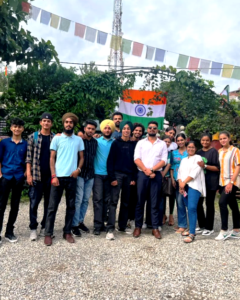Satellite Technology
The space-age began with the launch of the Russian artificial satellite Sputnik in 1957 and developed further with the race to the moon between the United States and Russia. This rivalry was characterized by advanced technology and huge budgets. In this process, there were spectacular successes, some failures, but also many spin-offs.
Europe, Japan, China, and India quickly joined this space club of the superpowers. With the advent of relatively low-cost high-performance mini-satellites and launchers, the acquisition of indigenous space capabilities by smaller nations in Asia has become possible. How, in what manner, and for what purpose will these capabilities be realized?
A Rocket technology has progressed considerably since the days of ‘fire arrows’ (bamboo poles filled with gunpowder) first used in China around 500 BC, and, during the Sung Dynasty, to repel Mongol invaders at the battle of Kaifeng (Kai-fung fu) in AD 1232. These ancient rockets stand in stark contrast to the present-day Chinese rocket launch vehicles, called the ‘Long March’, intended to place a Chinese astronaut in space by 2005 and, perhaps, to achieve a Chinese moon-landing by the end of the decade.
B In the last decade, there has been a dramatic growth in space activities in Asia both in the utilization of space-based services and the production of satellites and launchers. This rapid expansion has led many commentators and analysts to predict that Asia will become a world space power. The space-age has had dramatic effects worldwide with direct developments in space technology influencing telecommunications, meteorological forecasting, earth resource and environmental monitoring, and disaster mitigation (flood, forest fires, and oil spills). Asian nations have been particularly eager to embrace these developments.
C New and innovative uses for satellites are constantly being explored with potential revolutionary effects, such as in the field of health and telemedicine, distance education, crime prevention (piracy on the high seas), food and agricultural planning and production (rice crop monitoring). Space in Asia is very much influenced by the competitive commercial space sector, the emergence of low-cost mini-satellites, and the globalization of industrial and financial markets. It is not evident how Asian space will develop in the coming decades in the face of these trends. It is, however, important to understand and assess the factors and forces that shape Asian space activities and development in determining its possible consequences for the region.
D At present, three Asian nations, Japan, China, and India, have comprehensive end-to-end space capabilities and possess a complete space infrastructure: space technology, satellite manufacturing, rockets, and spaceports. Already self-sufficient in terms of satellite design and manufacturing, South Korea is currently attempting to join their ranks with its plans to develop a launch site and spaceport. Additionally, nations in Southeast Asia as well as those bordering the Indian subcontinent (Nepal, Pakistan, and Bangladesh), have, or are starting to develop indigenous space programmes. The Association of Southeast Asian Nations (ASEAN) has, in varying degrees, embraced space applications using foreign technology and over the past five years or so its space activities have been expanding. Southeast Asia is predicted to become the largest and fastest-growing market for commercial space products and applications, driven by telecommunications (mobile and fixed services), the Internet, and remote sensing applications. In the development of this technology, many non-technical factors, such as economics, politics, culture, and history, interact and play important roles, which in turn affect Asian technology.
E Asia and Southeast Asia, in particular, suffers from a long list of recurrent large-scale environmental problems including storms and flooding, forest fires and deforestation, and crop failures. Thus the space application that has attracted the most attention in this region is remote sensing. Remote sensing satellites equipped with instruments to take photographs of the ground at different wavelengths provide essential information for natural resource accounting, environmental management, disaster prevention and monitoring, land-use mapping, and sustainable development planning. Progress in these applications has been rapid and impressive. ASEAN members, unlike Japan, China, and India, do not have their own remote sensing satellites, however, most of its member nations have facilities to receive, process, and interpret such data from American and European satellites. In particular, Thailand, Malaysia, and Singapore have world-class remote sensing processing facilities and research programmes. ASEAN has plans to develop (and launch) its own satellites and in particular remote sensing satellites. Japan is regarded as the dominant space power in Asia and its record of successes and quality of technologies are equal to those of the West. In view of the technological challenges and high risks involved in space activities, a very long, and expensive, the learning curve has been followed to obtain those successes achieved. Japan, s satellite manufacturing was based on the old and traditional defense and military procurement methodologies as practiced in the US and Europe.
F In recent years there have been fundamental changes in the way satellites are designed and built to drastically reduce costs. The emergence of ‘small satellites’ and their quick adoption by Asian countries as a way to develop low-cost satellite technology and rapidly establish a space capability has given these countries the possibility to shorten their learning curve by a decade or more. The global increase of technology transfer mechanisms and use of readily available commercial technology to replace costly space and military-standard components may very well result in a highly competitive Asian satellite manufacturing industry.
G The laws of physics are the same in Tokyo as in Toulouse, and the principles of electronics and mechanics know no political or cultural boundaries. However, no such immutability applies to engineer practices and management; they are very much influenced by education, culture, and history. These factors, in turn, have an effect on costs, lead times, product designs and, eventually, international sales. Many Asian nations are sending their engineers to be trained in the West. Highly experienced, they return to work in the growing Asian space industry. Will this acquisition of technical expertise, coupled perhaps with the world-renowned Japanese manufacturing and management techniques, be applied to build world-class satellites and reduce costs?
Questions 1-5
The reading passage has seven paragraphs, A-G. Choose the correct heading for paragraphs A-G from the list below. Write the correct number, i-ix, in boxes 1-5 on your answer sheet.
List of Headings
i Western countries provide essential assistance
ii Unbalanced development for an essential space technology
iii Innovative application compelled by competition
iv An ancient invention which is related to the future
v Military purpose of the satellite
vi Rockets for application in ancient China
vii Space development in Asia in the past
viii Non-technology factors counts
ix competitive edge gained by more economically feasible satellite
1. Paragraph A
2. Paragraph B
3. Paragraph C
4. Paragraph E
5. Paragraph F
Questions 6-9
Match the following reasons for each question according to the information given in the passage. Write the correct letter A-F, in boxes 6-9 on your answer sheet.
A Because it helps administrate the crops.
B Because there are some unapproachable areas.
C Because the economic level in that area is low.
D Because there are influences from some other social factors.
E Because it can be used in non-peaceful purpose.
F Because disasters such as bush fire happened in Southeast Asia.
6. Why remote-photographic technology is used to resolve environmental problems?
7. Why satellites technology is used in the medicine area?
8. Why Asian countries satellite technology is limited for development?
9. Why satellites technology is deployed in an agricultural area?
Questions 10-13
Do the following statements agree with the information given in Reading Passage? In boxes 10-13 on your answer sheet, write
TRUE if the statement agrees with the information
FALSE if the statement contradicts the information
NOT GIVEN if there is no information on this
10. Ancient China had already deployed rockets as a military purpose as early as 500 years ago.
11. Space technology has enhanced the literacy of Asia.
12. photos taken by satellites with certain technology help predict some natural catastrophes prevention and surveillance.
13. commercial competition constitutes a boosting factor to Asian technology development.
Koalas
A Koalas are just too nice for their own good. And except for the occasional baby taken by birds of prey, koalas have no natural enemies. In an ideal world, the life of an arboreal couch potato would be perfectly safe and acceptable.
B Just two hundred years ago, koalas flourished across Australia. Now they seem to be in decline, but exact numbers are not available as the species would not seem to be ‘under threat’. Their problem, however, has been man, more specifically, the white man. Koala and aborigine had co-existed peacefully for centuries.
C Today koalas are found only in scattered pockets of southeast Australia, where they seem to be at risk on several fronts. The koala’s only food source, the eucalyptus tree has declined. In the past 200 years, a third of Australia’s eucalyptus forests have disappeared. Koalas have been killed by parasites, chlamydia epidemics and a tumour-causing retro-virus. And every year 11000 are killed by cars, ironically most of them in wildlife sanctuaries, and thousands are killed by poachers. Some are also taken illegally as pets. The animals usually soon die, but they are easily replaced.
D Bush fires pose another threat. The horrific ones that raged in New South Wales recently killed between 100 and 1000 koalas. Many that were taken into sanctuaries and shelters were found to have burnt their paws on the glowing embers. But zoologists say that the species should recover. The koalas will be aided by the eucalyptus, which grows quickly and is already burgeoning forth after the fires. So the main problem to their survival is their slow reproductive rate – they produce only one baby a year over a reproductive lifespan of about nine years.
E The latest problem for the species is perhaps more insidious. With plush, grey fur, dark amber eyes and button nose, koalas are cuddliness incarnate. Australian zoos and wildlife parks have taken advantage of their uncomplaining attitudes, and charge visitors to be photographed hugging the furry bundles. But people may not realise how cruel this is, but because of the koala’s delicate disposition, constant handling can push an already precariously balanced physiology over the edge.
F Koalas only eat the foliage of certain species of eucalyptus trees, between 600 and 1250 grams a day. The tough leaves are packed with cellulose, tannins, aromatic oils and precursors of toxic cyanides. To handle this cocktail, koalas have a specialised digestive system. Cellulose- digesting bacteria in the break down fibre, while a specially adapted gut and liver process the toxins. To digest their food properly, koalas must sit still for 21 hours every day.
G Koalas are the epitome of innocence and inoffensiveness. Although they are capable of ripping open a man’s arm with their needle-sharp claws, or giving a nasty nip, they simply wouldn’t. If you upset a koala, it may blink or swallow, or hiccup. But attack? No way! Koalas are just not aggressive. They use their claws to grip the hard smooth bark of eucalyptus trees.
H They are also very sensitive, and the slightest upset can prevent them from breeding, cause them to go off their food, and succumb to gut infections. Koalas are stoic creatures and put on a brave face until they are at death’s door. One day they may appear healthy, the next they could be dead. Captive koalas have to be weighed daily to check that they are feeding properly. A sudden loss of weight is usually the only warning keepers have that their charge is ill. Only two keepers plus a vet were allowed to handle London Zoo’s koalas, as these creatures are only comfortable with people they know. A request for the koala to be taken to meet the Queen was refused because of the distress this would have caused the marsupial. Sadly, London’s Zoo no longer has a koala. Two years ago the female koala died of a cancer caused by a retrovirus. When they come into heat, female koalas become more active, and start losing weight, but after about sixteen days, heat ends and the weight piles back on. London’s koala did not. Surgery revealed hundreds of pea-sized tumours.
Almost every zoo in Australia has koalas – the marsupial has become the Animal Ambassador of the nation, but nowhere outside Australia would handling by the public be allowed. Koala cuddling screams in the face of every rule of good care. First, some zoos allow koalas to be passed from stranger to stranger, many children who love to squeeze. Secondly, most people have no idea of how to handle the animals; they like to cling on to their handler, all in their own good time and use his or her arm as a tree. For such reasons, the Association of Fauna and Marine parks, an Australian conservation society is campaigning to ban koala cuddling. Policy on koala handling is determined by state government authorities. “And the largest of the numbers in the Australian Nature Conservation Agency, with the aim of instituting national guidelines. Following a wave of publicity, some zoos and wildlife parks have stopped turning their koalas into photo.
Questions 14-18
Choose the correct letter, A, B, C or D.
14. The main reason why koala declined is that they are killed EXCEPT FOR
A by poachers
B by diseases they got
C giving too many birth yet survived little!
D accidents on the road
15. What can help koalas folly digest their food?
A toxic substance in the leaves
B organs that dissolve the fibres
C remaining inactive for a period to digest
D eating eucalyptus trees
16. What would koalas do when facing the dangerous situation?
A show signs of being offended
B counter attack furiously
C use sharp claws to rip the man
D use claws to grip the bark of trees.
17. In what ways Australian zoos exploit koalas?
A encourage people to breed koalas as pets
B allow tourists to hug the koalas
C put them on the trees as a symbol
D establish a koala campaign
18. What would the government do to protect koalas from being endangered?
A introduce koala protection guidelines
B close some of the zoos
C encourage people to resist visiting the zoos
D persuade the public to learn more knowledge
Questions 19-25
Do the following statements agree with the information given in Reading Passage? In boxes 19-25 on your answer sheet, write
YES if the statement agrees with the views of the writer
NO if the statement contradicts the views of the writer
NOT GIVEN if it is impossible to say what the writer thinks about this
19. New coming human settlers caused danger to koalas.
20. Koalas can still be seen in most of the places in Australia.
21. It takes decade for the eucalyptus trees to recover after the fire.
22. Koalas will fight each other when food becomes scarce.
23. It is not easy to notice that koalas are ill.
24. Koalas are easily infected with human contagious disease via cuddling
25. Koalas like to hold a person’s arm when they are embraced.
Question 26
Choose the correct letter, A, B, C or D.
26. From your opinion this article written by
A a journalist who write for magazine
B a zoo keeper in London Zoo.
C a tourist who traveling back from Australia
D a government official who studies koalas to establish a law
Detection of a meteorite Lake
A As the sun rose over picturesque Lake Bosumtwi, a team of Syracuse University researchers prepared for another day of using state-of-the-art equipment to help bottom. Nestled in the heart of Ghana, the lake holds an untapped reservoir of information that could help scientists predict future climate changes by looking at evidence from the past. This information will also improve the scientists’ understanding of the changes that occur in a region struck by a massive meteorite.
B The project, led by earth sciences professor Christopher Scholz of the College of Arts and Sciences and funded by the National Science Foundation (NSF), is the first large-scale effort to study Lake Bosumtwi, which formed 1.1 million years ago when a giant meteor crashed into the Earth’s surface. The resulting crater is one of the largest and most well-preserved geologically young craters in the world, says Scholz, who is collaborating on the project with researchers from the University of Arizona, the University of South Carolina, the University of Rhode Island, and several Ghanaian institutions. “Our data should provide information about what happens when an impact hits hard, pre-Cambrian, crystalline rocks that are a billion years old,” he says.
C Equally important is the fact that the lake, which is about 8 kilometers in diameter, has no natural outlet. The rim of the crater rises about 250 meters above the water’s surface. Streams flow into the lake, Scholz says, but the water leaves only by evaporation, or by seeping through the lake sediments. For the past million years, the lake has acted as a tropical rain gauge, filling and drying with changes in precipitation and the tropical climate. The record of those changes is hidden in the sediment below the lake bottom. “The lake is one of the best sites in the world for the study of tropical climate changes,” Scholz says. “The tropics are the heat engine for the Earth’s climate. To understand the global climate, we need to have records of climate changes from many sites around the world, including the tropics.”
D Before the researchers could explore the lake’s subsurface, they needed a boat with a large, working deck area that could carry eight tons of scientific equipment. The boat – dubbed R/V Kilindi – was built in Florida last year. It was constructed in modules that were dismantled, packed inside a shipping container, and reassembled over a 10-day period in late November and early December 1999 in the rural village of Abono, Ghana. The research team then spent the next two weeks testing the boat and equipment before returning to the United States for the holidays.
E In mid-January, five members of the team – Keely Brooks, an earth sciences graduate student; Peter Cattaneo, a research analyst; and Kiram Lezzar, a postdoctoral scholar, all from SU; James McGill, a geophysical field engineer; and Nick Peters, a Ph.D. student in geophysics from the University of Miami – returned to Abono to begin collecting data about the lake’s subsurface using a technique called seismic reflection profiling. In this process, a high-pressure air gun is used to create small, pneumatic explosions in the water. The sound energy penetrates about 1,000 to 2,000 meters into the lake’s subsurface before bouncing back to the surface of the water.
F The reflected sound energy is detected by underwater microphones – called hydrophones – embedded in a 50-meter-long cable that is towed behind the boat as it crosses the lake in a carefully designed grid pattern. On-board computers record the signals, and the resulting data are then processed and analyzed in the laboratory. “The results will give us a good idea of the shape of the basin, how thick the layers of sediment are, and when and where there were major changes in sediment accumulation,” Scholz says. “We are now developing a three-dimensional perspective of the lake’s subsurface and the layers of sediment that have been laid down.”
G Team members spent about four weeks in Ghana collecting the data. They worked seven days a week, arriving at the lake just after sunrise. On a good day, when everything went as planned, the team could collect data and be back at the dock by early afternoon. Except for a few relatively minor adjustments, the equipment and the boat worked well. Problems that arose were primarily non-scientific – tree stumps, fishing nets, cultural barriers, and occasional misunderstandings with local villagers.
H Lake Bosumtwi, the largest natural freshwater lake in the country, is sacred to the Ashanti people, who believe their souls come to the lake to bid farewell to their god. The lake is also the primary source of fish for the 26 surrounding villages. Conventional canoes and boats are forbidden. Fishermen travel on the lake by floating on traditional planks they propel with small paddles. Before the research project could begin, Scholz and his Ghanaian counterparts had to secure special permission from tribal chiefs to put the R/V Kilindi on the lake.
I When the team began gathering data, rumors flew around the lake as to why the researchers were there. “Some thought we were dredging the lake for gold, others thought we were going to drain the lake or that we had bought the lake,” Cattaneo says. “But once the local people understood why we were there, they were very helpful.”
Questions 27-31
Do the following statements agree with the information given in Reading Passage? In boxes 27-31 on your answer sheet, write
TRUE if the statement agrees with the information
FALSE if the statement contradicts the information
NOT GIVEN if there is no information on this
27. With the investigation of the lake, the scientist may predict the climate changes in the future.
28. The crater resulted from a meteorite impact is the largest and most preserved one in the world.
29. The water stored in lake Bosumtwi was gone only by seeping through the lake sediments.
30. Historical climate changes can be detected by the analysis of the sediment in the lake.
31. The greatest obstacle to the research of scientists had been the interference by the locals due to their indigenous
Questions 32-35
There are three steps of collecting data from the lake as followings, please fill the blanks in the Flow Chart below:

32. ……………
33. ………….
34. ………….
35. ………….
Questions 36-40
Complete the following summary of the paragraph of reading passage using NO MORE THAN THREE WORDS from the Reading Passage for each answer. Write your answers in boxes 36-40 on your answer sheet.
The boat-double R/V Kilindi crossed the lake was dismantled and stored in a (36)………………. The technology they used called (37)………………..; They created sound energy into 1000-2000 metres into the bottom of the lake and used separate equipment to collect the returned waves. Then the data had been analyzed and processed in the (38)……………… Scholz also added that they were now building (39)…………….. View of the sediment or sub-image in the bottom of the lake. The whole set of equipment works well yet the ship should avoid physical barrier including tree stumps or (40)……………….. Floating on the surface of the lake.








